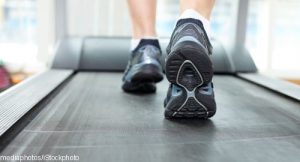 Although several previous studies have described a relationship between physical activity and rheumatoid arthritis (RA) risk, their designs made it difficult to determine if decreased physical activity causes RA or if RA causes decreased physical activity. Example: A 2018 analysis of data from the Women’s Health Initiative found a reduced risk of RA in women who reported a physical activity level of 17.5 metabolic equivalent (MET) hours weekly or more compared with those who were inactive. However, the investigators of the study assessed physical activity only at baseline and self-reported RA, making it difficult to determine causation.1
Although several previous studies have described a relationship between physical activity and rheumatoid arthritis (RA) risk, their designs made it difficult to determine if decreased physical activity causes RA or if RA causes decreased physical activity. Example: A 2018 analysis of data from the Women’s Health Initiative found a reduced risk of RA in women who reported a physical activity level of 17.5 metabolic equivalent (MET) hours weekly or more compared with those who were inactive. However, the investigators of the study assessed physical activity only at baseline and self-reported RA, making it difficult to determine causation.1
A recent large, prospective cohort study has taken a more detailed look at the relationship between physical activity and RA. This study provides a more nuanced understanding of the association between higher levels of physical activity and a reduction in RA risk. Xinyi Liu, MS, a programmer at Brigham and Women’s Hospital, Boston, and colleagues published their findings in the September 2019 issue of Arthritis & Rheumatology.2
The study adds to a growing body of literature that implicates metabolic factors in the pathogenesis of RA. “For women with ≥7 total recreational activity hours/week, RA risk was reduced by 33% compared to women with <1 hour/week, independent of other RA risk factors,” wrote the authors in their discussion, “In our study design, we excluded physical activity measures in the years prior to RA diagnosis so that these results would be less likely explained by early disease manifestations affecting physical activity before clinical diagnosis.”
The Study
The investigators used data from the Nurses’ Health Study II to identify validated incident RA cases during 2.5 million person-years over up to 26 years of follow-up (mean ± SD of follow-up of 21.4 ± 5.1 years per participant). Most of the women in the study were white and had a normal body mass index (BMI) at age 18. The investigators used validated questionnaires approximately every four years to assess self-reported levels of physical activity during the many years of follow up. They also gathered detailed data on important confounders, such as smoking, dietary intake and BMI at age 18, as well as updated data during follow up. They identified incident RA cases by reviewing medical records and verifying patients met the criteria for RA.
The researchers analyzed data from 113,366 women and identified 506 incident RA cases, 67% of which were seropositive RA. They found increasing time spent in recreational activity was associated with a reduced risk of RA. When the investigators adjusted for potential confounders, including age, questionnaire period, smoking, median household income, U.S. geographic region, parity status, dietary quality and BMI at age 18, they calculated a hazard ratio (HR) of 1.00 for less than one hour weekly, HR of 1.00 for one to two hours weekly, HR of 0.93 for two to four hours weekly, HR of 0.84 for four to seven hours weekly and HR of 0.67 for more than seven hours weekly. These HRs represented a significant trend toward a reduced overall RA risk associated with increasing cumulative average total of recreational hours per week (P=0.02). When the researchers adjusted their analyses for co-morbidities, such as cancer, cardiovascular disease and diabetes, they found these co-morbidities did not explain their findings. The authors also calculated the proportion of the effect between physical activity and RA mediated by an updated BMI was 14.0% (P=0.002) for all RA and 20.0% (P=0.001) for seropositive RA. Thus, although updated BMI was a strong mediator between physical activity and seropositive RA, it was not a strong mediator for seronegative RA.
The authors note that although they designed the study to minimize the potential for reverse causation bias, it’s possible the association between exercise and RA may be explained by symptoms of early RA. But if that were the case, these symptoms would had to have occurred two to eight years prior to clinical diagnosis.
Nevertheless, because one of the first symptoms of RA is a limitation in physical activity, the investigators performed a secondary analysis in which they lagged the assessment of physical activity and RA risk window by an additional questionnaire cycle. This secondary analysis expanded the window between physical activity assessment and the RA risk window to at least 4–10 years. Although the analysis included fewer RA cases, the results matched those seen in the primary analysis, suggesting this documented decrease in activity would have to be a very early symptom if it were a symptom at all.
A Key Prevention Tool
Like previous studies, this research identified a statistically significant effect among women with brisk and very brisk walking paces such that longer cumulative average walking hours weekly appeared to reduce the risk of RA. Because walking seemed to be the main contributor to the composite variable of recreational activity, the researchers investigated it more closely. They found brisk and very brisk walking—but not an easy or average walking pace—seemed to be the activity driving the association between recreational activity and RA.
Senior author Jeffrey A. Sparks, MD, MMSc, an assistant professor of medicine at Brigham and Women’s Hospital and Harvard Medical School, Boston, explained that although he expected to see this sort of association in the year before RA diagnosis, he was surprised to see a clear and consistent association even many years before RA diagnosis. Moreover, he notes that walking is an activity that most people can do.
“We really saw a trend,” he says. “Increasing your physical activity seems to have a protective effect for RA risk. This is good news. There is a way to reduce your risk.”
Lara C. Pullen, PhD, is a medical writer based in the Chicago area.
References
- Krok-Schoen JL, Brasky TM, Hunt RP, at al. Dietary long-chain n-3 fatty acid intake and arthritis risk in the Women’s Health Initiative. J Acad Nutr Diet. 2018 Nov;118(11):2057–2069.
- X Liu, SK Tedeschi, B Lu, et al. Long-term physical activity and subsequent risk for rheumatoid arthritis among women: a prospective cohort study. Arthritis Rheumatol. 2019 Sep;71(9):1460–1471.

